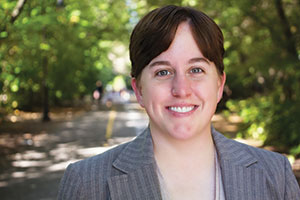
Former Ward 5 Alderman and long-time community advocate, Courtney O’Keefe.
By Courtney O’Keefe
Over 30 residents took to the West Somerville Neighborhood School Tuesday, March 11, to brainstorm ideas on how Somerville can best utilize its green spaces and community places with a concentration on playgrounds, community gardens, fields, plazas and streetscapes.
Kicking off the conversation were city officials Hayes Morrison (best name at City Hall), Luisa Oliveira, Sarah Spicer, Rachel Kelly and Arn Franzen, with each taking one of the above-mentioned topics and reviewing city data on it during a 30-minute presentation that included the totals of each and other topic-specific numbers.
The city has 141 acres of open space. This total is compiled of land owned by the city and privately owned land that is open to the public. For example, the open space in the middle of MaxWell’s Green is owned by the development but open to public use. SomerVision adds another 125 acres to the city’s total.
Once the presentation was completed, city officials took questions before breaking out into smaller groups to gather ideas and observations on each type of space/place. While in these small groups, residents were given the freedom to voice ideas and concerns for either specific spaces or all the spaces as a whole. The city provided maps of each space as reference.
Playgrounds
The city has 36 playgrounds total, with most of them being in good, usable shape. During the breakout session, I (alone) attended the discussion on playgrounds. With all of them named on a map, we began by pointing out some of the grounds that need improvement. This list included Hoyt-Sullivan playground in Ward 5, where I pointed out the need for improved lighting and an evaluation as to whether the apparatus was meeting the needs of the community. As a former sports director at the playground (hired by the founder of The Friends of Hoyt-Sullivan Playground and former member of the Magoun Square Revitalization Committee, Sheila Ehrens), the shade from surrounding trees is great on a hot, August day, but then make the space very dark at night. The conversation (during the small group session and full group session) then turned to innovative ideas that can be implemented in Somerville playgrounds. They included:
• Chalkboards on walls, both stationary and moveable
• Different climbing apparatuses such as ropes, parkour-like bars and other structures
• Ensuring the sightline for playgrounds allows easy visibility for parents and police
• Using existing structures in other ways for financially feasible changes
• Placing playgrounds on rooftops
Community gardens
With only 11 available, the group that focused on community gardens brought up some great ideas to increase the amount of gardens and deal with the unbelievably lopsided supply and demand. For every plot we have, there are two people waiting for one. (225/457)
• Allowing owners of plots to give their section away for a year or two without losing ownership
• Getting away from the “one size fits all” style. Smaller plots for singles, larger for families
• Using under-utilized spaces for gardens. This included Junction Park in Ward 5.
• Working with private landowners for increased space
Fields (recreational)
The discussion on recreational fields centered around making some of them multi-use spaces and allowing more availability for residents to use or rent them.
• Collaborative multi-age fields to allow parents to drop kids off at one location for games or practices
• Improved lighting
• Better scheduling of recreational fields
• Evaluation of parks usage during different times. For example, Trum is not used in the morning
• Decreasing the amount of pavement at Healey
• Sectioning off the parks to support different age levels. For example, smaller fields for younger kids, larger spaces for older kids
Plazas and streetscapes
Faced with the topic of how to best define space within residential neighborhoods and/or business districts, those who tackled this topic suggested using umbrellas, planters and trees to create flex space and incorporating art, as well. With 15 neighborhoods and seven squares, the possibilities may seem endless. However, Somerville’s density makes this more difficult than one would think.
• Define plazas and streetscapes. Space that is bordered by natural landscapes or storefronts
• Incorporate shade where needed by using umbrellas, planters and trees. These can be stationary or movable to create flex space
• Increase plazas by using current undefined space such as the pit in Teele Square or the small “plazette” in Magoun Square
• Incorporate art into space
• Increase sidewalk space
• Create outdoor living room making it comfortable and safe
As the discussions ended, city officials invited everyone to comment further ideas at somervillebydesign.com.
This won’t be the last time that Somerville will seek feedback on their open space. An online and hard copy survey will be created to bring in more data, suggestions and ideas for a final report that will be presented later in the year. Residents can also look forward to an art project and open space, open house event, as well.
Courtney O’Keefe operates the website www.ward5online.com.
Green/community spaces at a glance
Playgrounds:
• 36 total
Community gardens:
• 11 total
• 225 total plots
• No gardens in wards 4 or 7
• 457 occupy waiting lists (compiled from all 11 lists)
Fields:
• 10 recreational fields total
• Six city -owned, three state-owned, one Tufts-owned
• 18 fields total
• 16 natural surface, two artificial turf
Plazas and streetscapes:
• Seven squares
• 15 neighborhoods













Reader Comments